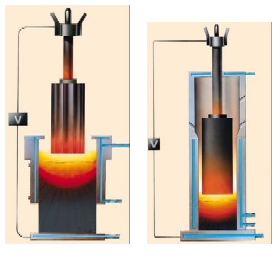Electro-slag remelting
Metallurgic process for the production of steel with high purity and a controlled solidified and respectively faultless structure, also known under the abbreviation ESR.
Under the influence of the electric arc, the electrode block inserted from the top (a continuously cast raw block of electric furnace steel is slowly melting in a hot slagbath (approx. 1800 °C) and drips through the slag that absorbs the contamination of the steel block. The block acts as current-carrying electrode (consumable electrode) and is the negative pole. The positive pole is a water-cooled copper mold. This way, the new and cleaned steal block forms under the liquid slag after solidification of the drops. The temperature of the slag is kept constant by means of a circuit. Steels that are produced this way feature improved technological properties.
In the ESR process (Fig. 1, left), the melt is only protected by the slag. The electrodes can be replaced as a moveable mold is used. This way, also large diameters can be produced. In the pressure electro-slag remelting (PESR) process (Fig. 1, right) a protection is applied to the melt by inert gas. This way, a reaction of the melt with air oxygen is prevented and nitrogen enrichment enabled. The electrodes cannot be replaced. A stationary mold is used in the process.


